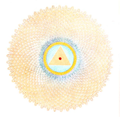Sahasrara
Sahasrara, also known as the crown chakra, is considered the seventh primary chakra according to most Yoga traditions and Tantric practices. Situated at the crown of the head, it is often depicted as a lotus with a thousand petals, symbolizing the infinite and the connection to the divine. Sahasrara is associated with the highest state of enlightenment and spiritual connection in various spiritual traditions, including Hinduism, Buddhism, and New Age practices.
Etymology and Symbolism[edit]
The term Sahasrara is derived from the Sanskrit words sahasra, meaning 'thousand', and ara, meaning 'spoke or wheel'. This chakra is visualized as a lotus flower with a thousand petals, each representing a different aspect of the mind and consciousness. The Sahasrara chakra is often associated with the color violet or white, symbolizing purity and the transcendence of the physical realm.
Location and Description[edit]
The Sahasrara chakra is located at the top of the head or slightly above it. Unlike the other six chakras, which are associated with specific parts of the body, the crown chakra is more concerned with the mind and spirit. It is the point of connection between the individual and the universe, the finite and the infinite.
Function and Importance[edit]
The primary function of the Sahasrara chakra is to facilitate spiritual connection and enlightenment. It is through this chakra that individuals can transcend the limitations of the physical body and the ego, experiencing a state of oneness with all that is. The Sahasrara chakra is also associated with higher states of consciousness, wisdom, and understanding.
Signs of Imbalance[edit]
A balanced Sahasrara chakra is characterized by a deep sense of peace, spiritual fulfillment, and a feeling of being connected to the universe. An imbalance in this chakra can manifest as a feeling of spiritual disconnection, cynicism, and a lack of purpose or direction. Physical symptoms may include neurological disorders, headaches, and mental health issues such as depression and anxiety.
Practices for Balancing[edit]
Balancing the Sahasrara chakra involves practices that promote spiritual growth and connection. These can include meditation, particularly focusing on the crown of the head, prayer, and engaging in activities that foster a sense of unity and oneness. Yoga practices such as headstands and other inversions can also stimulate the Sahasrara chakra.
Cultural and Spiritual Significance[edit]
The concept of the Sahasrara chakra has deep roots in Hindu philosophy, Buddhist meditation practices, and modern New Age spirituality. It is often associated with the ultimate goal of various spiritual paths, including the attainment of Nirvana in Buddhism and Moksha in Hinduism.
See Also[edit]

This article is a spirituality-related stub. You can help WikiMD by expanding it!
-
Sahasrara Mandala
-
Ayyavali Sahasrara
-
Brahmin practising Recaka in Pranayama
-
Bindu Chakra
-
Attoor Thangal
Ad. Transform your life with W8MD's Budget GLP-1 injections from $75


W8MD offers a medical weight loss program to lose weight in Philadelphia. Our physician-supervised medical weight loss provides:
- Weight loss injections in NYC (generic and brand names):
- Zepbound / Mounjaro, Wegovy / Ozempic, Saxenda
- Most insurances accepted or discounted self-pay rates. We will obtain insurance prior authorizations if needed.
- Generic GLP1 weight loss injections from $75 for the starting dose.
- Also offer prescription weight loss medications including Phentermine, Qsymia, Diethylpropion, Contrave etc.
NYC weight loss doctor appointmentsNYC weight loss doctor appointments
Start your NYC weight loss journey today at our NYC medical weight loss and Philadelphia medical weight loss clinics.
- Call 718-946-5500 to lose weight in NYC or for medical weight loss in Philadelphia 215-676-2334.
- Tags:NYC medical weight loss, Philadelphia lose weight Zepbound NYC, Budget GLP1 weight loss injections, Wegovy Philadelphia, Wegovy NYC, Philadelphia medical weight loss, Brookly weight loss and Wegovy NYC
|
WikiMD's Wellness Encyclopedia |
| Let Food Be Thy Medicine Medicine Thy Food - Hippocrates |
Medical Disclaimer: WikiMD is not a substitute for professional medical advice. The information on WikiMD is provided as an information resource only, may be incorrect, outdated or misleading, and is not to be used or relied on for any diagnostic or treatment purposes. Please consult your health care provider before making any healthcare decisions or for guidance about a specific medical condition. WikiMD expressly disclaims responsibility, and shall have no liability, for any damages, loss, injury, or liability whatsoever suffered as a result of your reliance on the information contained in this site. By visiting this site you agree to the foregoing terms and conditions, which may from time to time be changed or supplemented by WikiMD. If you do not agree to the foregoing terms and conditions, you should not enter or use this site. See full disclaimer.
Credits:Most images are courtesy of Wikimedia commons, and templates, categories Wikipedia, licensed under CC BY SA or similar.
Translate this page: - East Asian
中文,
日本,
한국어,
South Asian
हिन्दी,
தமிழ்,
తెలుగు,
Urdu,
ಕನ್ನಡ,
Southeast Asian
Indonesian,
Vietnamese,
Thai,
မြန်မာဘာသာ,
বাংলা
European
español,
Deutsch,
français,
Greek,
português do Brasil,
polski,
română,
русский,
Nederlands,
norsk,
svenska,
suomi,
Italian
Middle Eastern & African
عربى,
Turkish,
Persian,
Hebrew,
Afrikaans,
isiZulu,
Kiswahili,
Other
Bulgarian,
Hungarian,
Czech,
Swedish,
മലയാളം,
मराठी,
ਪੰਜਾਬੀ,
ગુજરાતી,
Portuguese,
Ukrainian




